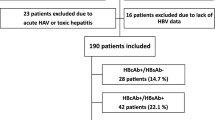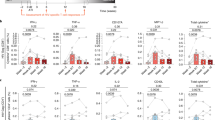Abstract
The effect of coinfection with hepatitis C virus (HCV) on immune restoration in 39 human immunodeficiency virus (HIV)-infected patients during treatment with combined antiretroviral therapy (cART) was prospectively evaluated. After 48 weeks of treatment, HCV-coinfected patients had lower increases in CD4% (P = .05), total CD4+ (P = .01), and naïve CD4+ (P = .06) T cells than did single-infected subjects. Higher baseline naïve CD4+ T-cell levels were associated with better CD4+ (P = .05) and naïve CD4+ (P < .001) T-cell recovery. After a 4-year follow up, the differences disappeared (median CD4+ increase: 291 and 306 cells for HCV-positive and HCV-negative patients, respectively, P = .9). No significant differences were seen in memory CD4+ T cells (P = .30), and CD8+ cells expressing CD38 (P = .10) and CD28 (P = .73). These results suggest that, independently of other factors, infection with HCV blunts early CD4+ T-cell recovery in HIV-infected patients treated with combined antiretroviral therapy (cART). However, as good control of viral replication is maintained, satisfactory long-term immune restoration can nonetheless be achieved.



Similar content being viewed by others
References
Sabin CA, Telfer P, Phillips AN, Bhagani S, Lee CA (1997) The association between hepatitis C virus genotype and human immunodeficiency virus disease progression in a cohort of hemophilic men. J Infect Dis 175:164–168
Piroth L, Duong M, Quantin C, Abrahamowicz M, Michardiere R, Aho LS, Grappin M, Buisson M, Waldner A, Portier H, Chavenet P (1998) Does hepatitis C virus co-infection accelerate clinical and immunological evolution of HIV-infected patients? AIDS 12:381–388
Greub G, Lederberger B, Battegay M, Grob P, Perrin L, Furrer H, Burgisser P, Erb P, Boggian K, Piffaretti JC, Hirschel B, Janin P, Francioli P, Flepp M, Telenti A (2000) Clinical progression, survival, and immune recovery during antiretroviral therapy in patients with HIV-1 and hepatitis C virus co-infection: the Swiss HIV cohort study. Lancet 356:1800–1805
De Luca A, Bugarini R, Cozzi Lepri A, Puoti M, Girardi E, Antinori A, Poggio A, Pagano G, Tositti G, Cadeo G, Macor A, Toti M, D’Arminio Monforte A, Italian Naïve Antiretrovirals Study Group (2002) Coinfection with hepatitis viruses and outcome of initial antiretroviral regimens in previously naïve HIV-infected subjects. Arch Intern Med 162:2125–132
Macias J, Pineda JA, Leal M, Abad MA, Garcia-Pesquera F, Delgado J, Gallardo JA, Sanchez-Quijano A, Lissen E (1998) Influence of hepatitis C virus infection on the mortality of antiretroviral-treated patients with HIV disease. Eur J Clin Infect Dis 17:167–170
Sulkowski MS, Moore RD, Mehta SH, Chaisson RE, Thomas DL (2002) Hepatitis C and progression of HIV disease. JAMA 288:199–206
Martin C, Castilla J, Lopez M, Arranz R, Gonzalez-Lahoz J, Soriano V (2004) Impact of chronic hepatitis C on HIV-1 disease progression. HIV Clin Trials 5:125–131
Lincoln D, Petoumenos K, Dore GJ, on behalf of the Australian HIV Observational Database (2003) HIV/HBV and HIV/HCV coinfection and outcomes following highly active antiretroviral therapy. HIV Med 4:241–249
Chung RT, Evans SR, Yang Y, Theodore D, Valdez H, Clark R, Shikuma C, Nevin T, Sherman KE, AIDS Clinical Trials Group 383 Study Team (2002) Immune recovery is associated with persistent rise in hepatitis C virus RNA, infrequent liver test flares, and is not impaired by hepatitis C virus in co-infected subjects. AIDS 16:1915–1923
Miller MF, Haley C, Koziel MJ, Rowley CF (2005) Impact of hepatitis C virus on immune restoration in HIV-infected patients who start highly active antiretroviral therapy: a meta-analysis. Clin Infect Dis 41:713–720
Autran B, Carcelain G, Li TS, Blanc C, Mathez D, Tubiana R, Katlama C, Debré P, Leibowitch J (1997) Positive effects of combined antiretroviral therapy on CD4+ T cell homeostasis and function in advanced HIV disease. Science 277:112–116
Plana M, Ferrer E, Martinez C, Podzamczer D, Garcia F, Maleno MJ, Barcelo JJ, Garcia A, Barbera MJ, Lacarcel M, Miro JC, Gallart, Gatell JM (2004) Immune restoration in HIV-positive, antiretroviral-naïve patients after 1 year of zidovudine/lamivudine plus nelfinavir or nevirapine. Antivir Ther 9:197–204
Mestre M, González C, Griñó JM, Valls A, Bonete J, Mane E, Corominas M, Bas J, Romeu A, Buendia E (1992) Sequential monitoring of immunoregulatory T cell subsets in renal transplantation. Transplant Proc 24:73–75
Michael CG, Kirk O, Mathiesen L, Nielsen SD (2002) The naïve CD4+ count in HIV-infected patients at time of initiation of highly active antiretroviral therapy is strongly associated with the level of immunological recovery. Scand J Infect Dis 34:45–49
Mildvan D, Bosch RJ, Kim RS, Spritzler J, Haas DW, Kuritzkes D, Kagan J, Nokta M, DeGruttola V, Moreno M, Landay A (2004) Immunophenotypic markers and antiretroviral therapy (IMART): T cell activation and maturation help predict treatment response. J Infect Dis 89:1811–1820
Kaufmann GR, Furrer H, Ledergerber B, Perrin L, Opravil M, Vernazza P, Cavassini M, Bernasconi E, Rickenbach M, Hirschel B, Battegay M, the Swiss HIV Cohort Study (2005) Characteristics, determinats, and clinical relevance of CD4 T cell recovery to <500 cells/μL in HIV type 1-infected individuals receiving potent antiretroviral therapy. Clin Infect Dis 41:361–372
Voirin N, Trepo C, Esteve J, Chevallier P, Ritter J, Fabry J, Vanhems P (2002) Effects of co-infection with hepatitis C virus and GB virus C on CD4 cell count and HIV-RNA level among HIV-infected patients treated with highly active antiretroviral therapy. AIDS 16:1556–1559
Rodriguez B, Woolley I, Lederman MM, Zdunek D, Hess G, Valdez H (2003) Effect of GB virus coinfection on response to antiretroviral treatment in human immunodeficiency virus-infected patients. J Infect Dis 187:504–507
Macias J, Pineda JA, Lozano F, Corzo JE, Ramos A, Leon E, Garcia-Garcia JA, Fernandez-Rivera J, Mira JA, Gomez-Mateos J (2003) Impaired recovery of CD4+ cell counts following highly active antiretroviral therapy in drug-naïve patients coinfected with human immunodeficiency virus and hepatitis C virus. Eur J Clin Microbiol Infect Dis 22:675–680
Law WP, Duncombe CJ, Mahanontharit A, Boyd MA, Ruxrungtham K, Lange JM, Phanuphak P, Cooper DA, Dore GJ (2004) Impact of viral hepatitis co-infection on response to antiretroviral therapy and HIV disease progression in the HIV-NAT cohort. AIDS 18:1169–1177
Lerat H, Berby F, Trabaud MA, Vidalin O, Major M, Trepo C, Inchauspe G (1996) Specific detection of hepatitis C virus minus strand RNA in hematopoietic cells. J Clin Invest 97:845–851
Radkowski M, Wang LF, Vargas H, Rakela J (1998) The presence of active hepatitis C virus replication in lymphoid tissue in patients coinfected with human immunodeficiency virus type 1. J Infect Dis 178:1189–1192
Lucas GM, Cheever LW, Chaisson RE, Moore RD (2001) Detrimental effects of continued illicit drug use on the treatment of HIV-1 infection. J Acquir Immune Defic Syndr 27:251–259
Liu Z, Cumberland WG, Hultin LE, Prince HE, Detels R, Giorgi JV (1997) Elevated CD38 antigen expression on CD8+ T cells is a stronger marker for the risk of HIV disease progression to AIDS and death in the multicenter AIDS cohort study than CD4+ cell count, soluble immune activation markers, or combinations of HLA-DR and CD38 expression. J Acquir Immune Defic Syndr Hum Retrovirol 16:83–92
Carbone J, Gil J, Benito JM, Navarro J, Muñoz-Fernandez A, Bartolome J, Zabay JM, Lopez F, Fernandez-Cruz E (2000) Increased levels of activated subsets of CD4 T cells add to the prognostic value of low CD4 T cell counts in a cohort of HIV-infected drug users. AIDS 14:2823–2829
Anthony KB, Yoder Ch, Metcalf JA, DerSimonian R, Orenstein JM, Stevens RA, Falloon J, Polis MA, Lane HC, Sereti I (2003) Incomplete CD4 cell recovery in HIV-1 infection after 12 months of highly antiretroviral therapy is associated with ongoing increased CD4 T cell activation and turnover. J Acquir Immune Defic Syndr 33:125–133
Appay V, Dunbar PR, Callan M, Klenerman P, Gillespie GM, Papagno L, Ogg GS, King A, Lechner F, Spina CA, Little S, Havlir DV, Richman DD, Gruener N, Pape G, Waters A, Easterbrook P, Salio M, Cerundolo V, McMichael AJ, Rowland-Jones SL (2002) Memory CD8+ T cells vary in differentiation phenotype in different persistent virus infections. Nat Med 8:379–385
Lucas M, Vargas-Cuero AL, Lauer GM, Barnes E, Willberg CH, Semmo N, Walker BD, Phillips R, Klenerman P (2004) Pervasive influence of hepatitis C virus on the phenotype of antiviral CD8+ T cells. J Immunol 172:1744–1753
Bürguisser P, Hammann C, Kaufmann D, Battegay M, Rutschmann OT (1999) Expression of the CD28 and CD38 by the CD8+ T lymphocytes in HIV infection correlates with markers of disease severity and changes towards normalization under treatment. Clin Exp Immunol 115:458–463
Landay AL, Spritzler J, Kessler H, Mildvan D, Pu M, Fox L, O’Neil D, Schock B, Kuritzkes D, Lederman MM; AIDS Clinical Trials Group 5014 Team (2003) Immune reconstitution is comparable in antiretroviral-naïve subjects after 1 year of successful therapy with a nucleoside reverse-transcriptase inhibitor- or protease inhibitor-containing antiretroviral regimen. J Infect Dis 188:1444–1445
Acknowledgements
The authors thank Isaac Ruiz (Department of Infectious Diseases) for assistance with statistical analysis.
Previous presentation
This paper was presented in part at the 43rd Interscience Conference on Antimicrobial Agents and Chemotherapy, Chicago, IL, USA, September 14–17, 2003. Title: Immune restoration and dynamics of hepatitis C virus (HCV)-RNA in HIV-HCV coinfected patients treated with HAART. (Abstract number: H-827). Financial support:
This study was funded by the Fundació “La Marató TV3” 2,000 [grant: 000910].
Author information
Authors and Affiliations
Corresponding author
Rights and permissions
About this article
Cite this article
Santin, M., Mestre, M., Shaw, E. et al. Impact of hepatitis C virus coinfection on immune restoration during successful antiretroviral therapy in chronic human immunodeficiency virus type 1 disease. Eur J Clin Microbiol Infect Dis 27, 65–73 (2008). https://doi.org/10.1007/s10096-007-0384-3
Published:
Issue Date:
DOI: https://doi.org/10.1007/s10096-007-0384-3




